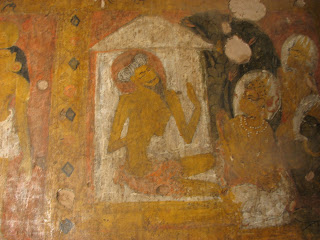I always like to look at the communication media in foreign countries. It can be very telling. We watched a little TV - pixelled out plunging necklines and thigh high slits in the Miss Universe contest were quite hilarious. My mother would approve.
But, needless to say, we spent the main part of our day visiting pagodas and temples - the former housed Buddha relics and the latter Buddha images - or the opposite - anyway, these were lively, vibrant places where people do lots of things and generally hang out. So they are prime advertising spaces. Like in the cathedrals of Europe where the teachings of the Bible are displayed in stained-glass windows and bas relief carvings, many pagodas featured the story of Buddha and his teachings in different media, mural paintings, glass mosaics (shown below), carvings, statues etc.
However, there were often panels with very modern messages as well. One in particular caught my attention as it seemed to give the rules and regs for good living. This one is apparently 'Don't Drink'...

This one I couldn't figure out exactly, but I think the gist is 'Don't Talk Smack or you wil really annoy your neighbor'
In the street, there were other messages. This one warns against bad driving. I love the close up of the terrified guy.
This one was displayed in a tea house where we had lunch one day. It was not a tourist restaurant by any stretch of the imagination, but the sign was in English, which I appreciated. Again, good advice.
And finally, by our western standards, you would think that this is an ad for Large and Lovely clothing, but it's just a regular ad, for regular clothes with nice, plump women for models. There were the same types for jewelry and cold relief medicine and coffee. The message? "Plump and White is Beautiful." Who knew?!!



















